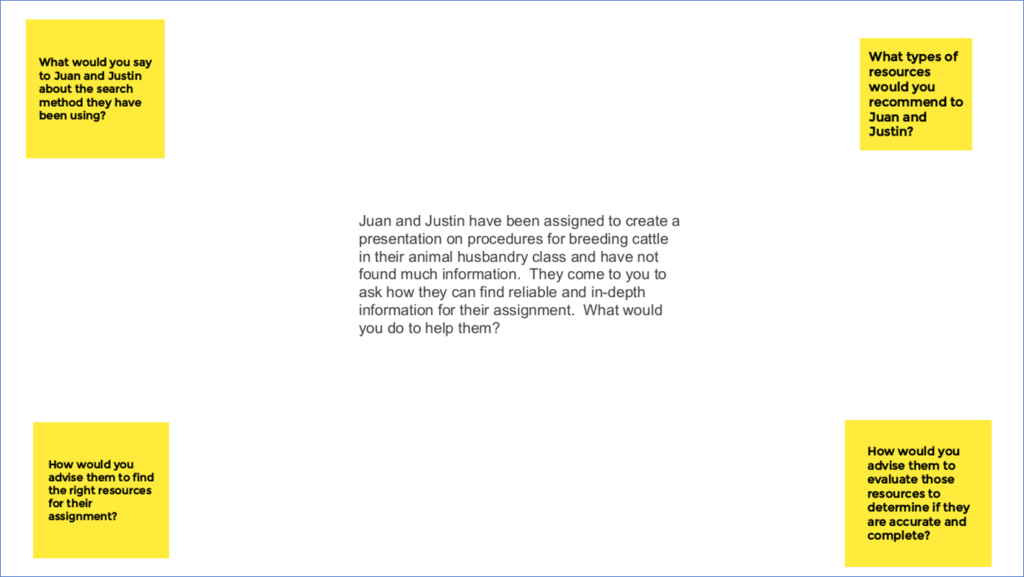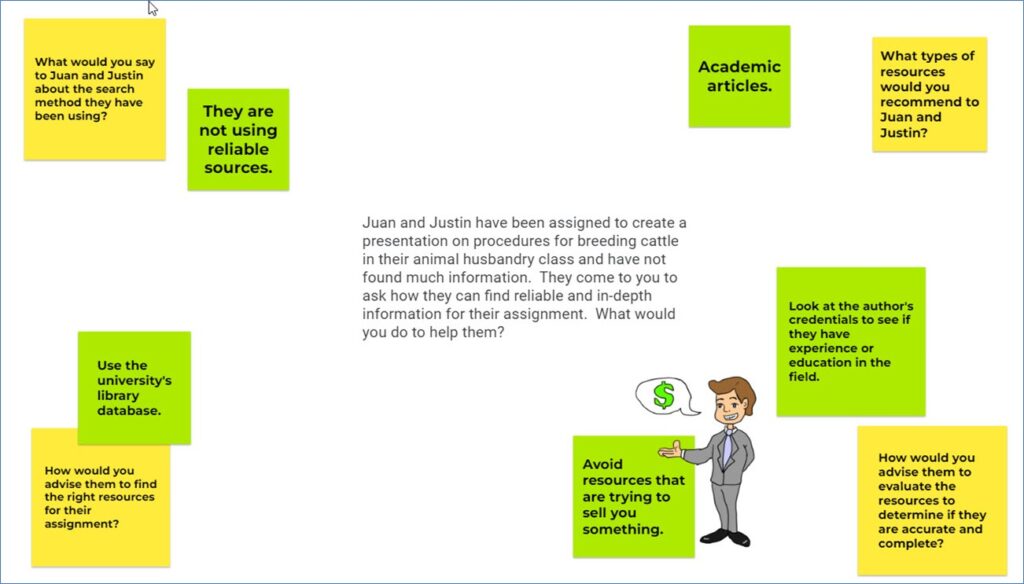Online faculty are often looking for ways to add real-time discussion to their asynchronous courses. But discussions fall flat when only a handful of students participate. I found an activity that solves this problem by combining videoconferencing with group work and a whiteboard in a way that gets all students engaged and contributing. The subsequent paragraphs will discuss the concept of four squares whiteboard activity.
The four squares activity
I teach Essentials of Scholarly Research, which covers how students can find, evaluate, and incorporate scholarly research into their work. I wanted students to work together to apply what they learned and got them to do so by hosting a number of Zoom meetings in which I put students into groups to work on real-life scenarios.
The meetings open with a prompt like the following:
Juan and Justin have been assigned to create a presentation on procedures for breeding cattle in their animal husbandry class and have not found much information. They come to you to ask how they can find reliable and in-depth information for their assignment. What would you do to help them?
I then put students into breakout rooms of about four participants each to work on the prompt for 20 minutes. They then reconvene as a full class, and each group reports on their results.
Faculty commonly use breakout rooms to facilitate small group discussion in video conferences, but they usually just ask students to talk and then to report back to the large group with their ideas. This leads to uneven contributions from different students. Partly the problem is that some students free ride, leaving others to carry the load. But it’s also that students prefer to be active in front of a computer. They are used to interacting with their digital devices by texting, taking photos, and the like, so they become disengaged when talking only to a screen.
To combat both problems, I set up a whiteboard for each group in Google Jamboard, a free app that allows users to draw, post images or videos, and organize content with digital sticky note text boxes. The four squares activity scaffolds student work visually by putting the prompt in the middle of the board. Then the instructor posts four question within blocks at the corners of the board. For the prompt above activity, I use the following questions:
- What would you say to Juan and Justin about the search method they have been using?
- What types of resources would you recommend to Juan and Justin?
- How would you advise them to find the right resources for their assignment?
- How would you advise them to evaluate those resources to determine whether they are accurate and complete?

Here instructors have different options for structuring the small group work. They can put four students into each group and have one student take each of the questions or have students post replies to any or all of the questions. The former option ensures that everyone participates, though getting participation with either option is generally not a problem due to the engaging activity.
The replies can take the form of text within boxes, preferably a different color from the boxes used for the questions to distinguish them. But students can also get creative by finding and posting images that represent concepts, such as a screenshot of the library’s database search engine. Students like finding images such as GIFs and memes to express ideas, and so this visual organization of their responses creates greater interest in the activity than simply talking about the questions. Plus, because students can all post to the board simultaneously, they all can work at once rather than have to speak in turn. The result is more ideas than would come out of a conversation alone.

I have found that students enjoy adding notes, changing colors, and giving feedback in real time during the Jamboard breakout sessions. Try the four-square activity in your live video discussions.
Amy Dye-Reeves, MLIS, is an associate education and history librarian at Texas Tech University.






